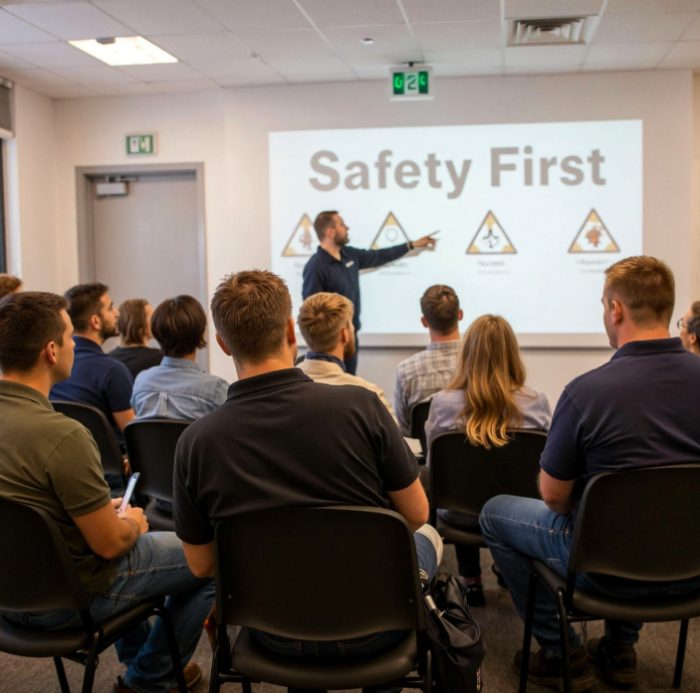
@ShahidNShah


Contractors are a familiar presence across workplaces in every industry. Whether it involves a one-day job or a long-term construction project, many businesses rely on contractors to carry out essential tasks. But even when the job is outsourced, the responsibility for safety stays in-house. When someone is injured, whether they are staff or not, it’s the employer that must answer the difficult questions.
Unlike permanent employees, contractors move between unfamiliar worksites. They often use tools or systems they haven’t encountered before, and they work alongside people who might not know their way of working. This lack of familiarity increases risk. When safety training is missing, the chances of incidents multiply.
Training closes that gap. It gives contractors the knowledge to recognise site-specific hazards, follow established procedures and avoid common mistakes. That keeps everyone safer. It also protects businesses from reputational damage, legal consequences and financial losses. These are not minor concerns — they’re critical issues that demand attention from the start of any contract.
Yet, contractor training is sometimes treated as optional or postponed for convenience. This article explores why contractor safety training is essential and how the right approach makes a real difference.
It’s easy to delay safety training when deadlines are tight. Some employers still treat it as a formality. But ignoring it comes at a cost.
An untrained contractor might use equipment incorrectly, bypass safety controls or overlook site rules. That can cause injury or even death. And in such cases, the Health and Safety Executive (HSE) investigates the employer, not just the individual. That’s because UK law places the duty of care on the company controlling the premises.
There’s also the risk of property damage, project delays and lost productivity. The impact goes beyond the individual. It can stop operations entirely, disrupt client relationships and result in hefty compensation claims.
Take something like abrasive wheel use. The abrasive wheel training cost is minor compared to the consequences of a mishandled grinder or cutting tool. An accident involving such equipment can damage machinery, endanger nearby workers and lead to fines or enforcement notices. Cutting corners simply isn’t worth it.
Contractor safety training isn’t a suggestion. It’s a legal requirement. Several UK laws outline the duties employers must meet, with some applying specifically to contractors.
The Health and Safety at Work etc. Act 1974 sets the foundation. It requires employers to ensure the health and safety of anyone affected by their operations, including visitors and contractors.
The Management of Health and Safety at Work Regulations 1999 expand on this by requiring risk assessments and appropriate controls. Employers must consider the risks to contractors and take steps to reduce them.
The Construction (Design and Management) Regulations 2015 (CDM Regulations) go further in construction settings. They assign clear duties to clients, contractors, designers and workers. Under CDM, contractors must be competent. That means they must have the right knowledge, skills, experience and training to carry out their work safely.
Inductions alone are not enough. Employers must provide suitable information, instruction and supervision. And the standard is the same regardless of whether the contractor is on site for two hours or two months.
A basic health and safety talk isn’t sufficient. A contractor safety training programme should be well-planned and task-specific.
The starting point is always induction. This should include:
Following that, the contractor should receive training tailored to the specific risks of their work. This could include:
Training should be supported by short assessments or verbal checks to confirm understanding. In many cases, toolbox talks and regular safety briefings help reinforce knowledge and keep safety fresh in workers’ minds.
If contractors are working unsupervised or on high-risk activities, a more robust assessment of competence may be necessary. This includes checking training records, verifying experience and observing them at work.
Safety training isn’t just about ticking boxes. It improves real-world outcomes.
Consider a project where contractors are working at height. If everyone has received appropriate fall prevention training, the likelihood of serious incidents is significantly reduced. In one example, a worker slipped but was protected by a properly secured harness. The only reason it was worn and fitted correctly was the recent training session he had attended.
Another case involved an electrical contractor on a maintenance job. He assumed power had been isolated, but it hadn’t. No one had shown him the control procedures. The incident led to severe injury, months of downtime and legal penalties for the employer.
In contrast, companies that provide structured and consistent training see benefits beyond safety. Projects are completed faster, fewer days are lost to injury or investigations, and insurers safetylook favourably on businesses with robust safety processes.
Some tasks are simply more dangerous. In such cases, training needs to go beyond general awareness.
Examples include:
Contractors may claim to be experienced in these areas, but that isn’t enough. Employers must confirm that the training they’ve received aligns with the hazards present on the site.
Competence must be matched to the environment. One contractor may know how to use a scissor lift, but not be familiar with local ground conditions, traffic routes or emergency arrangements. That’s why ongoing communication and supervision are essential.
For those involved in construction-related activities, completing a CDM awareness training course is one way to ensure that both employers and contractors understand the responsibilities outlined in the regulations.
Employers sometimes cite cost or time as reasons for avoiding formal training. But those objections rarely stand up to scrutiny.
Short, site-based sessions can be delivered in less than an hour. Online learning modules are also available for many safety topics. These are flexible, affordable and easy to track. The format isn’t what matters most — what counts is that the training happens and is understood.
Another common barrier is language. Many contractors speak English as a second language, which can make training less effective. The solution is to use plain English, visual materials, translated documents or bilingual trainers. If the training isn’t understood, then it fails. And failure puts everyone at risk.
Employers may also assume that contractors will handle their own training. While that may be true in some cases, the legal duty does not disappear. The host company must verify that training is current, relevant and appropriate to the task. This might mean checking certifications, asking for evidence or offering refresher training before work starts.
Contractors are vital to business operations. They bring expertise, flexibility and the ability to complete specialised tasks without permanent overhead. But they also introduce unfamiliarity and, with it, potential risks.
Proper safety training protects people, projects and reputations. It fulfils legal duties, reduces disruption and helps maintain good working relationships. It ensures contractors are prepared, competent and confident in the work they’re doing.
Ultimately, safety is everyone’s responsibility. But the responsibility to provide training — and to check it’s been effective — sits with the employer. For organisations serious about avoiding harm and protecting their workforce, contractor safety training isn’t an optional add-on. It’s a critical investment in every project’s success.

Home-based care is changing the way we think about healthcare. More families today are choosing to have their loved ones treated in familiar surroundings rather than in hospitals or nursing …
Posted Oct 20, 2025 Home Health
Connecting innovation decision makers to authoritative information, institutions, people and insights.
Medigy accurately delivers healthcare and technology information, news and insight from around the world.
Medigy surfaces the world's best crowdsourced health tech offerings with social interactions and peer reviews.
© 2025 Netspective Foundation, Inc. All Rights Reserved.
Built on Dec 26, 2025 at 4:08am